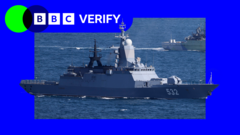Following reported incidents of damage to undersea cables between Finland and Estonia, NATO and local governments are responding to perceived security threats, as suspicions rise about Russian operations in the area.
NATO Enhances Military Presence in the Baltic Amid Cable Sabotage Allegations

NATO Enhances Military Presence in the Baltic Amid Cable Sabotage Allegations
In response to alleged Russian sabotage of critical undersea power links, NATO increases its presence in the Baltic region while Estonia deploys a patrol ship for protection.
Estonia has increased its military response by sending the patrol boat Raju to safeguard its Estlink 1 undersea power cable after accusations arose that Russian activities were responsible for damage to its power infrastructure. The Eagle S, a ship linked to Russia's so-called "shadow fleet," has been highlighted in relation to the suspected sabotage of the nearby Estlink 2 cable in the Gulf of Finland. The incident has prompted both concerns over national security and the stability of energy supplies in the region.
The Estonian Defence Minister Hanno Pevkur confirmed the Raju's deployment early on Friday, emphasizing its mission to protect vital connections with Finland, amid expectations that Finland may also contribute to the maritime security effort. NATO Secretary General Mark Rutte announced increased military presence in the Baltic, facilitating discussions between Estonian Prime Minister Kristen Michal and Finnish President Alexander Stubb regarding potential NATO reinforcements.
The recent disruption to Estonia's power supply marks a significant turning point, as the Estlink 2 cable—covering 170 kilometers—has been rendered non-operational, with repairs estimated to extend through July 2025. This sabotage incident follows other disruptions within a month, including the severing of two data cables and a previous attack on an undersea gas pipeline—events believed to be strategically orchestrated amid rising geopolitical tensions.
Suspicions about the involvement of a Chinese ship, the Yi Peng 3, in dragging its anchor over undersea cables have surfaced, adding another layer to the concerns regarding international maritime conduct. Following a coordinated inspection by authorities from multiple countries, the Eagle S was boarded and escorted towards Finnish waters, where authorities confirmed its loss of anchor.
To reassure the public, Estonian officials, including Prime Minister Michal, affirmed that power supplies would remain stable through backup systems available at local power companies, even as challenges persist in securing the region's underwater infrastructure. The collaborative investigations into the incidents continue, with European Union officials exploring measures to address the broader implications of the "shadow fleet" and associated threats to regional security and environmental integrity.
The Estonian Defence Minister Hanno Pevkur confirmed the Raju's deployment early on Friday, emphasizing its mission to protect vital connections with Finland, amid expectations that Finland may also contribute to the maritime security effort. NATO Secretary General Mark Rutte announced increased military presence in the Baltic, facilitating discussions between Estonian Prime Minister Kristen Michal and Finnish President Alexander Stubb regarding potential NATO reinforcements.
The recent disruption to Estonia's power supply marks a significant turning point, as the Estlink 2 cable—covering 170 kilometers—has been rendered non-operational, with repairs estimated to extend through July 2025. This sabotage incident follows other disruptions within a month, including the severing of two data cables and a previous attack on an undersea gas pipeline—events believed to be strategically orchestrated amid rising geopolitical tensions.
Suspicions about the involvement of a Chinese ship, the Yi Peng 3, in dragging its anchor over undersea cables have surfaced, adding another layer to the concerns regarding international maritime conduct. Following a coordinated inspection by authorities from multiple countries, the Eagle S was boarded and escorted towards Finnish waters, where authorities confirmed its loss of anchor.
To reassure the public, Estonian officials, including Prime Minister Michal, affirmed that power supplies would remain stable through backup systems available at local power companies, even as challenges persist in securing the region's underwater infrastructure. The collaborative investigations into the incidents continue, with European Union officials exploring measures to address the broader implications of the "shadow fleet" and associated threats to regional security and environmental integrity.




















